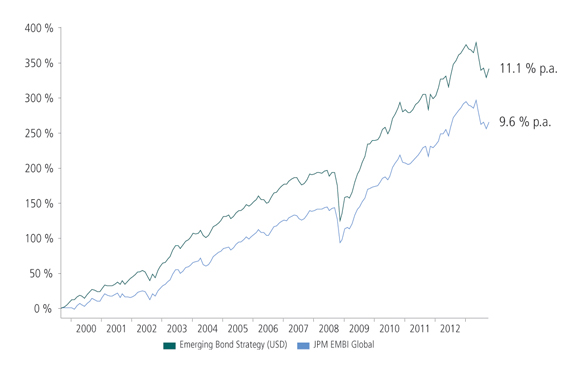Emerging markets: keeping the faith

|
Written By: Matthew Lamb |
Despite recent underperformance, Matthew lamb of GAM outlines why emerging market debt continues to offer long-term performance opportunities
In recent years, emerging markets have become the undisputed driver of global growth, their economies expanding through a combination of both investment and consumer growth. The emerging market crises in the 1990s prompted a decade of reforms that paved the way for a remarkable evolution such that today, many emerging market countries .demonstrate macroeconomic fundamentals that are superior to those of most developed countries.. These dynamics helped emerging market bonds significantly outperform post 2008. From 2009 to 2012, EM bonds returned 85% versus a modest 17% for developed market bonds.1
Yet, performance in 2013 has been a little different. Back in late spring, concerns over the Fed’s plans to begin tapering its asset purchasing programme sent global markets into a tailspin – and emerging markets, which have benefited from extraordinary flows of capital, were particularly badly hit. Indeed, EM bonds fell over 10%2 in the month following Bernanke’s initial announcement in May.
Markets have rebounded to some extent following the Fed’s subsequent and unexpected decision to hold back from tapering (for now). However, to the end of September, EM bonds were still down over 7% YTD, underperforming their developed counterparts which were down just under 3%.1
So what’s next for emerging markets?
We believe that the future will be no less challenging than the most recent years have been. Even without a quick normalisation of interest rates, government bond markets such as US Treasuries, German Bunds or UK Gilts offer little chance for capital gains.
To be able to generate meaningful real returns, institutional investors either have to expand their fixed income universe to include segments such as emerging markets, or they have to adopt a more flexible investment approach that allows them to adjust their portfolio dynamically in line with market developments. The ideal solution would be to combine both these approaches.
Strong fundamentals remain…
Solid growth and debt fundamentals speak in favour of a long-term exposure to emerging markets. For decades to come, growth rates in emerging markets are likely to outpace growth in the developed world, driven by healthy demographics and a growing working population, an emerging middle class of consumers, strong productivity gains and the development of the financial system.
…valuations are favourable and yields are attractive…
The summer sell-off left EM valuations at multi-year lows, creating a broad set of attractive opportunities. EM bonds and currencies offer good value for investors in a global environment where fixed income yields are likely to drift higher. Yield is likely to be an important contributor to total returns going forward, and the additional 5% over US Treasuries offered by EM debt provides a healthy margin of safety.
…but the asset class requires an active and discerning approach
Against this backdrop, a highly disciplined and active investment approach is critical to investing in emerging markets. The pronounced volatility of the asset class requires a continuous rebalancing of portfolios in order to take advantage of the best opportunities.
Swiss & Global’s Fixed Income team has been managing emerging market strategies since 1997. The team is led by Enzo Puntillo, Head and CIO of Fixed Income at Swiss & Global, an independent, active asset manager and a member of GAM Holding AG which manages USD 10 billion in EM bonds. With over 20 years’ industry experience, Enzo and his team have built an established expertise and outstanding track record in both hard and local currency EM strategies: sovereign, investment grade, corporate, inflation-linked and absolute return.
The team conducts fundamental analysis to assess the current macroeconomic and political situation of each country, to identify trends (and deviations from trends) and turning points and to determine possible crisis candidates. The team combines this output with a framework that focuses on absolute and relative valuations to determine whether the team’s fundamental picture of a country is fairly priced by the market. Finally, the team also considers technical factors, which focus on short-term dynamics and timing and looks at sentiment and risk appetite, supply and demand dynamics, market liquidity and transaction costs.
The constant comparison between asset “quality” and asset “prices” is at the heart of every investment decision the team takes. Any potential investment must exhibit strong and improving fundamentals combined with an attractive valuation.
As economic cycles tend to be an important driver of credit cycles, the team constructs portfolios based on their ability to understand where we are in the cycle and to position their portfolios to capture near-term and longer-term dynamics as those cycles progress.
Figure 1: Swiss & Global emerging bond strategy performance to Sep 2013
Source: Swiss & Global, inception date 24 August 1999, in USD
Past performance is not indicative of future performance. Performance is provided net of fees.
Inflation-linked bonds offer attractive opportunities
Within EM, the team believes that inflation-linked bonds will become one of the most interesting investment instruments for bond investors in the coming two to three years. As inflationary pressure in emerging markets continues to be fuelled by structural and cyclical forces, these instruments offer investors the ability to protect themselves from this trend while continuing to benefit from the high real yields, steep yield curves, and attractive long-dated returns emerging markets currently offer.
One current example is Mexico. After the recent correction, the team favours the country’s long dated CPI-linked bonds, due to a compelling combination of robust debt fundamentals – overall low debt level and solid liquidity profile – and attractive valuation. The steep yield curve means investors can currently lock in a real yield of around 3.4% (which equates to a 7% plus nominal yield after inflation).
The longer-term outlook remains compelling
Global uncertainty has always been coupled with volatility in emerging markets, and the recent corrections are no exception. Uncertainties about the global growth outlook and a potential reduction of the Fed’s expansionary monetary policy will linger, but little has changed fundamentally. If anything, such corrections offer investors more attractive entry points. For institutional investors willing to accept short-term volatility, the longer-term outlook for emerging market bonds remains compelling.
1. EM bonds = JP Morgan EMBI Global in USD, Developed bonds = Citigroup WGBI in USD
2. JP Morgan EMBI Global in USD
More Related Content...
|
|
|




